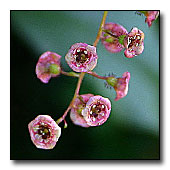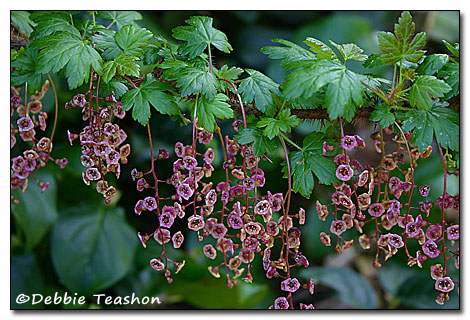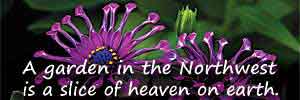Ribes lacustre
SWAMP GOOSEBERRY, BLACK GOOSEBERRY, PRICKLY CURRANT, BLACK SWAMP GOOSEBERRY, BRISTLY BLACK GOOSEBERRY, BRISTLY BLACK CURRANT, SWAMP CURRANT
syn. Limnobotrya lacustris, Ribes oxycanthoides var. lacustre, Ribes lacustre var. parvulum
Family: Grossulariaceae
Pronounced: RyE-bees luh-KUS-tree

Quick Jumps
Growing Guide
Rainy Side Notes
GROWING GUIDE
Play video to view more images of Ribes lacustre.
Origin:
Alaska, California, Colorado, Connecticut, Idaho, Maine, Massachusetts, Michigan, Minnesota, Montana, New Hampshire, New Jersey, Nevada, New York, Oregon, Pennsylvania, Rhode Island, South Dakota, Utah, Virginia, Vermont, Washington, Wisconsin, West Virginia and Wyoming, and Canada.
Plant Group:
Shrubs.
Hardiness:
Sunset zones: Not listed.
USDA zones:4-8.
Mature size:
Height: 3-5 feet (90-150 cm).
Width: 5 feet (150 cm).
Flowering period:
Mid spring to early summer.
Flowering attributes:
Racemes holding 5 to 15, tiny, pink to purple flowers that age to cinnamon hues, with green or purple sepals; a saucer-shaped calyx and short stamens are followed by ¼-inch, dark purple-to-black berries covered in glandular hairs.
Leaf attributes:
Deciduous, maple-like, green leaves, 1½-2 inches across, with 3-7 deep lobes, alternately arranged on stems with prickles between the nodes and sharp spines at the nodes.
Light:
Full sun to partial shade.
Soil:
Moist, humus rich soil.
Propagation Methods:
Sow fresh seed in fall and place in cold frame. If seed is stored, allow 4-6 month cold stratification and plant in early spring. Seed is viable for 17 years.
Take semi-ripe cuttings in fall.
Pests and Diseases:
Mostly disease resistant; however, all ribes can harbor white pine blister rust, so growing near pines is not recommended. Susceptible to honey fungus.
Rainy Side Notes

Ribes comes from the Arabic word ribas, which means acid-tasting (fruit). Lacustre comes from the Latin word lacus, which means "of lakes."
I found this plant growing near seepage from our foundation drains. I didn't recognize the flowers, but the branches with prickles looked a lot like the California native Ribes speciosum. Intrigued by the many racemes of tiny pink flowers dangling from its branches and cinnamon-colored bark, I was delighted to find it growing on the property and identified it soon after. By delighted, I mean anytime I can find a new native species on my property, I am thrilled.
The difference between a currant and gooseberry is that the latter will goose you with its prickles, while the currants are disarmed. Yet Ribes lacustre's many common names include both. Nevertheless, this has lots of prickles along its stems. So, I favor calling it black swamp gooseberry since that name is descriptive of its black berries and its favorite place to grow. Besides, gooseberries are the ones with the prickles.
This native shrub grows throughout Canada and many U.S. states, from coastlines to subalpine elevations. It is threatened in Connecticut and Massachusetts; in Pennsylvania, it's on the endangered list due to habitat loss. The plant grows in the Pacific Northwest and other states in wetlands, creeks, seeps, and swamps. It is at home in non-wetlands, rocky soils, and forests. In addition, it can take drier conditions when grown in shade.
In the landscape, the prickly shrubs make practical barrier hedges where they can grow erect or sprawl lower to the ground. This species is helpful in areas that are too wet for most plants. For wildlife, the flowers provide nectar for hummingbirds. In contrast, the berries provide food for birds such as towhees, cedar waxwings, grouse and woodpeckers. Mammals such as chipmunks, coyotes, deer, elk, foxes, mountain beavers, porcupines, raccoons, skunks, and squirrels also eat the dark black fruit.
The berries are strong-tasting but palatable when ripe and make a tasty jam. Use caution when handling this shrub; the spines are known to cause skin reactions in some people.
Ethnobotany
Native Americans around the Northwest region utilized every part of Ribes lacustre for food, fiber, tools, and medicinal purposes. Although the Swinomish considered the prickles poisonous, the Oweekeno thought the whole plant was noxious. This may be partly because of some people's allergic skin reactions after being scratched by the prickles.
The Bella Coola, Haisla, Hanaksiala, and Skagit used the fruit for food. The Salish boiled and dried the berries to make cakes for winter use. Thompson people buried the fresh berries for later use and dried them, too.
For rope, the Saanich boiled the roots with cedar and rose roots, then pounded them and wove them into rope. The Cowichan used the roots to make reef nets. The Salish used the spines to poke boils, remove splinters and as a tattoo tool.
If someone should have an allergic reaction to the prickles, the Bella Coola chewed the bark and leaves and tied the concoction to the sores. They also made a laxative out of the roots to help with constipation. However, another tribe outside the region used the plant as an antidiarrheal. To give newborns intelligence and obedience, the Saanich bathed the child in a wash of cherry and swamp gooseberry roots.
The Skagit people peeled the bark and boiled it for tea. During childbirth, women would drink it. The Skagit and Lummi used the tea for body aches and as a wash for sore eyes. The Thompson took the cambium layer to make a wash for sore eyes. A tonic for the stomach was made with wood, while a decoction of roots and stems was used for someone with a slight illness.
Photographed in author's garden.

Gardening for the Homebrewer: Grow and Process Plants for Making Beer, Wine, Gruit, Cider, Perry, and More
By co-authors Debbie Teashon (Rainy Side Gardeners) and Wendy Tweton
Copyright Notice | Home | Search | Natives

